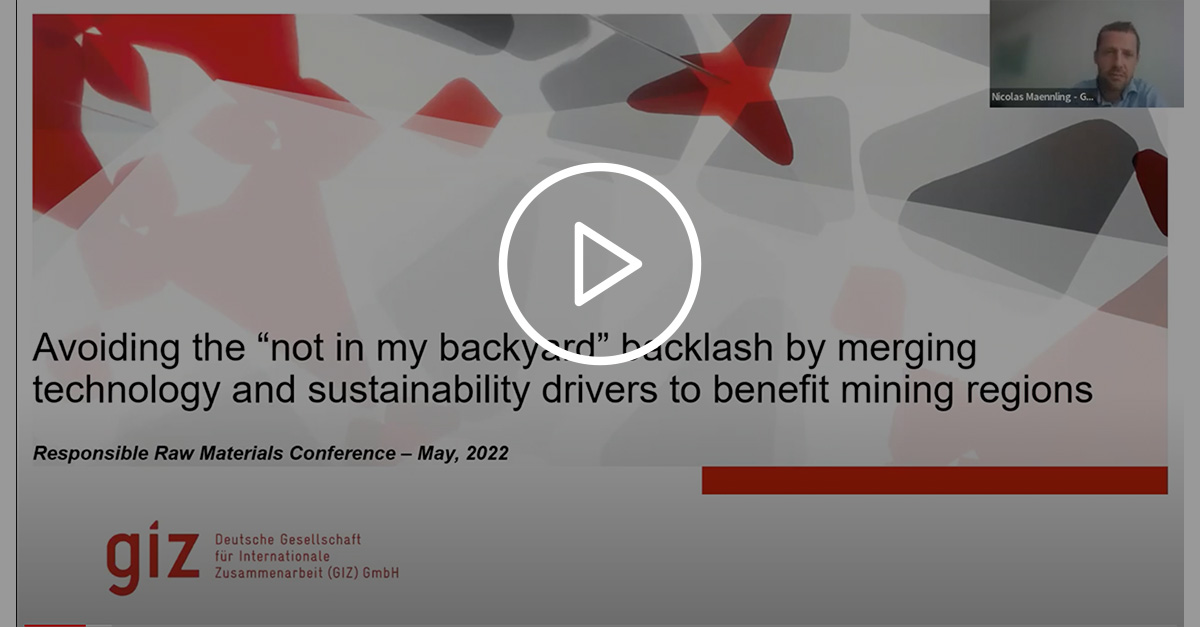
Thursday, May 12, 2022
The mining sector in the Andean region is experiencing a technological revolution that has been accelerated by the pandemic. The technological changes are here to stay and bring with it opportunities and challenges. On the one hand, new technologies have the potential to increase productivity and competitiveness, reduce the environmental footprint and improve the monitoring / transparency of mining projects. On the other hand, some traditional jobs are at risk, as the sector requires people with different skills.
MinSus, a German Cooperation Project that aims to promote responsible mining practices in the Andean countries, in collaboration with the Center for Copper and Mining Studies (CESCO), have brought together stakeholders working in the mining sector to assess the differentiated impacts that technological changes may have on rural mining regions, on mining cities and on metropolitan cities. While rural mining regions may lose out due to new skill requirements and procurement needs, there are opportunities for new actors to enter the space in mining cities and metropolitan cities due to new technological demands. With close coordination between mining companies and the public sector, the transition for employees with traditional skills can be smoothened and the opportunities for technology-oriented startups promoted. The results of this research can be accessed here and forms part of the global IGF assessment, which can be accessed here.
Apart from these findings, one important result from the literature review and discussions amongst the mining stakeholders was that a holistic approach needs to be taken, which combines the technological revolution with the sustainability trends to get a better picture of the potential impacts of the mine of the future at the local, national and regional levels. This led to a follow-up cooperation between MinSus and CESCO whereby five sustainability opportunities relevant for the mining sector were picked to assess the potential within selected Andean countries. The five sustainability opportunities include: (1) shared-use water infrastructure investments, (2) electrification of mine trucks, (3) circular economy, (4) nature-based solutions, and (5) greenhouse gas emission offsets through a regional carbon club.
The results, which will be published shortly, show that by merging the technological and sustainability trends, additional opportunities can be identified for the sector to play an important development driver in mining regions. For example, while new technologies may displace workers with basic skills from rural mining regions, shared-use water infrastructure investments at the local level in the north of Chile and south of Peru, which suffers from water scarcity, could create new opportunities in the agriculture and husbandry sectors. At the national level, the example of grinding ball production based on discarded materials from the mining sector could create economic opportunities while advancing circular economy concepts. At the regional level, it has been estimated that about 3500 haul trucks in Chile and Peru alone (an important proportion of the global fleet) will need to be replaced or retrofitted in the next years to reduce the carbon footprint. The assembling or retrofitting of these trucks tailored to the mining context where the trucks will operate could generate important economic opportunities while reducing emissions.
These are just some examples of how new opportunities arise by taking a more holistic view of the technological developments with the sustainability trends. What all of these have in common, is that cooperation is needed amongst mining companies and with the public sector. For example, governments need to coordinate actors in a water basin and set clear rules around water access and tariffs if shared water-infrastructure investments are to work. To advance in the electrification of mine trucks, a non-competitive environment whereby mining companies work together to test and scale new technologies will lead to faster results than if each mining company works on its own solutions. To address circular economy challenges, laws in the Andean countries need to be adapted for mine waste to be allowed to be used as inputs for new processes and industries. Furthermore, potential circular economy solutions will only work at scale if various mining companies coordinate to share information and make stocks available.
In short, the technological transformation and sustainability challenges that the mining sector is facing are tremendous. Addressing each of these challenges requires context specific know-how and technical expertise. It is important though not to lose sight of connecting the dots between the technological and development drivers to ensure that the mine of the future will benefit mining regions and for the sector to regain the social approval, which it is currently lacking in many parts of the Andean region. The message that mining is needed to implement the energy transition at the global scale due to the mineral intensity of low-carbon technologies, needs to be supplemented by showing that future mining projects can act as important development contributors where mining occurs.
 Contact us
Contact us Newsletter
Newsletter Courses
Courses

